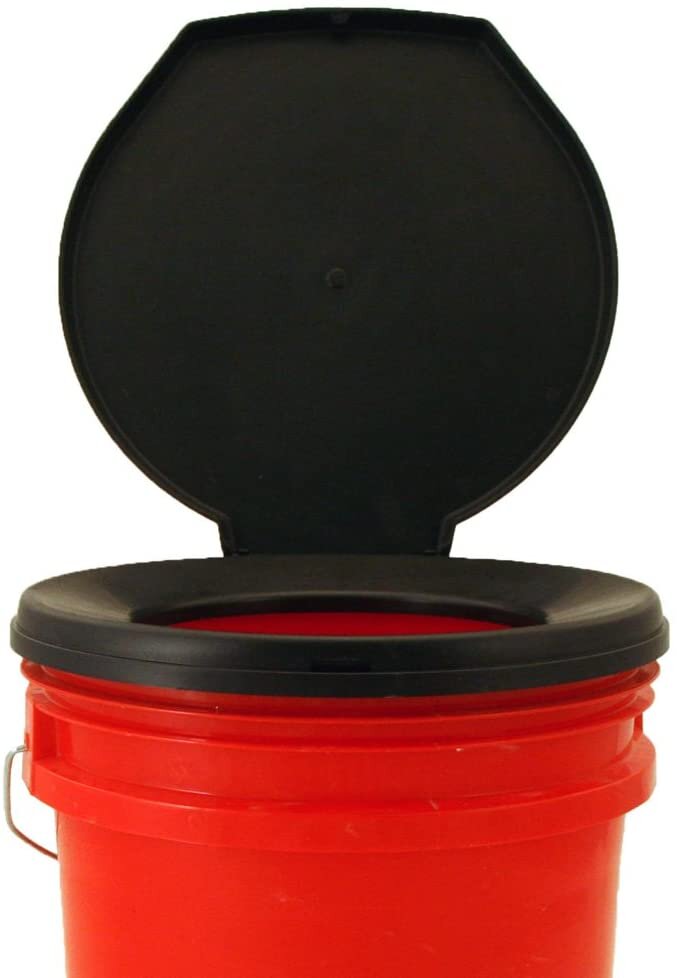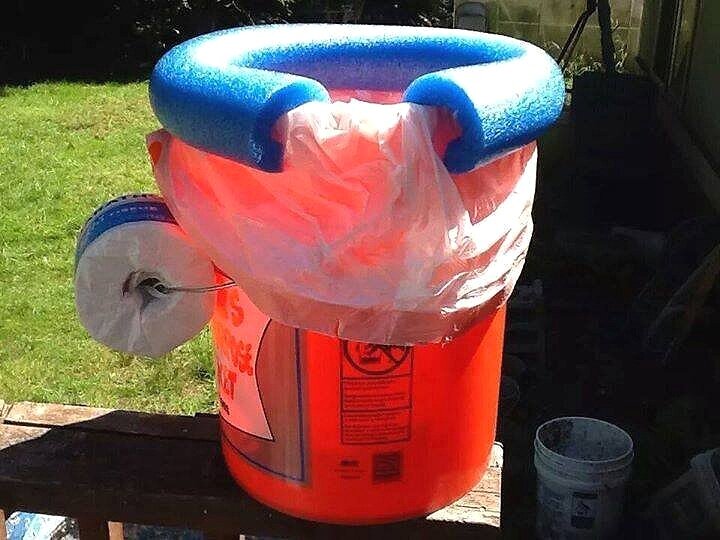You never know when a natural disaster or an emergency will occur and you find yourself without the luxury of indoor plumbing. We often take for granted with a simple flick of a lever, our waste is removed from our homes and out of sight for good. But what do you do when the water to your home stops flowing and suddenly your toilets don’t work anymore? The backup of sewage in your home not only creates a terrible smell but poses a significant health risk to you and anyone else in your home. This is when you take inventory of the everyday items around you and figure out how to make an emergency DIY toilet!
One of the simplest DIY emergency toilets you can make involves placing a trash bag inside a 5 gallon bucket and cutting a foam noodle to fit around the top for comfort.
When You May Need An Emergency Toilet

There are many scenarios that could occur where you could find yourself with out access to running water. The most common would be some sort of natural disaster like a hurricane, earthquake or even just a bad storm.
Anyone that’s on well water and relies on the use of an electric well pump to provide water to your home is especially at risk. All it takes is a bad storm to knock out your power and you will be left without running water and the ability to flush your toilet. For those of you on public water, there are many situations that could cause a water main to burst or even just lose all pressure. These situations include earthquakes, flooding or land slides or just poor maintenance by your local city.
Portable toilets are also incredibly useful for those who enjoy camping but want to find the right balance between “roughing it” and modern luxuries like regular toilets. A portable toilet may not be practice for overnight trips in the back country but can be a welcomed luxury for anyone building a camp site near their vehicle or setting up a semi-permanent camp site, such as a hunting camp.
Public and private septic systems can also fail after severe flooding. It’s not uncommon after a few days of heavy rain or after the storm surge from a major hurricane for septic systems to fail or even back up into your home. This could leave you without a safe & hygienic way of disposing of your family’s waste.
Items that you need to build your DIY emergency toilet:
- 5 gallon bucket
- Trash bag or other liner
- A foam noodle
- Toilet paper
- Hand Sanitizer (optional but recommended)
Steps To Making Your DIY Emergency Toilet
- Pop out one end of the metal handle of the bucket by simply tugging it out by hand or with pliers.
- Place the toilet paper through the open end of the handle so that it reaches the middle of the handle and push the handle back into the original bucket hole. You can still use this handle to help in transportation.
- Line your bucket with a standard garbage bag to keep your bucket clean and re-usable. You can use trash bags which are about 1.5ft x 2.5ft and it will hold up to 8 gallons of waste which is more than enough for several uses if need be. If in a pinch, you can also use grocery bags, although I recommend making these only for one time use. No need for a rubber band or other rope to secure the trash bag to the bucket.
- Make foam padding for your toilet seat by simply cutting a foam noodle. Cut about 3ft long and then cut a clean slit in the side and place it on the bucket. For comfort, it’s helpful if you don’t wrap the foam noodle all the way around the bucket but instead leave about a 4” gap between the ends. The foam noodle will keep the trash bag secured in your bucket.
- (Optional) Store some sort of absorption material near by to use between uses to cut down on odors.
- Store additional items in the bottom of your bucket beneath the liner such as hand sanitizer, toilet paper and addition bags.
Absorption Materials
Absorption materials refer to anything that can soak up some of the liquids and reduce your odors. These can keep your DIY toilet from stinking up your entire home. A few examples include:
- Saw Dust
- Peat Moss
- Newspapers strips
- Cat Litter
- Baking Soda

Emergency Toilet Liners
Trash Bags: The ideal liner would be a large trash bag. These are ideal because of their strength and waterproofness. The last thing you want is for your trash bag to tear on you. The large volume of the bag is also incredibly helpful. This gives you excess which you can grab or even tie in a knot after removing it from the toilet.
If you have access to enough trash bags, you should replace the bag after every use. Simply tie the excess into a knot and drop the secured bag into the bucket itself for storage. However, if you have limited resources or have multiple people using this toilet, you could replace the bag at the end of each day. In a worst case scenario, you could go several days without replacing the bag liner.
Grocery Bags: This is a less than ideal option but may be easier for you to find in an emergency. These are not ideal because they hold less volume than a trash bag making this more of a one time use option. Grocery bags are much easier to tear as well which means you may have more “leakage” in your toilet as well as when you remove your liner.
Plastic Sheets: In a real emergency when you can’t find any sort of plastic bags, you can resort to cutting sections out of sheets of plastic. You can use items such as shower curtains, ponchos and any other plastic sheets you can find. Ideally you would cut at least a 4’ x 4’ section so you have enough extra to tie into a knot after use.
No Bag: A third option if you can not find any of the above items for your emergency toilet, is to simply cut the bottom out of the toilet and let your waste sit where it falls. This may seem pointless but there are many people who simply prefer sitting on a comfortable seat over squatting, especially if you are not on your typical diet and things are moving a little slower for you.
DIY 5 Gallon Bucket Toilet
Now your DIY emergency toilet is ready for use. Just pop off the foam noodle and remove the liner after a few uses, depending on how many trash bags you have access to, and then drop the tied bag into the bucket for temporary storage.
Because of the ability to replace the toilet paper and trash bags when needed, your emergency toilet should last you a long time. I recommend also keeping a bottle of hand sanitizer and extra bags in your toilet.
This DIY toilet design is also incredibly portable which also makes it ideal for camping trips or to keep in your vehicles for emergencies on the road. The portability of this DIY toilet makes it come in handy for those who seek isolation and privacy for their BM’s.
DIY Toilet VS Store Bought Toilet
There are many portable toilets you can purchase online for use in an emergency, for camping or traveling. A portable toilet like this one from Zimmer Portable Toilet comes with it’s own re-fillable water tank and a manual pump which allows you to flush your waste into a closed holding tank. This combined with a closable lid greatly cuts down on smells.
The downside to buying a travel toilet like this is going to be the size of the unit and of course the price with many of these types of units ranging from $125 to $175.
These are a popular choice for those who enjoy traveling long distances or those who lose home power to their well pump often.
Another option, which I personally like, would be simply buying a 5 gallon bucket and a bucket toilet seat lid for it. This still allows you to use trash bags as your toilet liner like in your DIY toilet but these toilet lids give you the ability to close and secure the top of your toilet which will greatly reduce the smell and sanitation of this toilet. The conforming plastic seat will also be easier to clean than a foam noodle. For the price of about $15, I think this is a great option for anyone worried about not having access to a working toilet during a natural disaster or emergency.

Whether you buy a portable toilet or build a DIY toilet, these make a great addition to your homes disaster/emergency preparations. Not just for comfort but also for health concerns. Waste management can very quickly become a serious issue in the aftermath of a bad hurricane, tornado or earthquake, especially if you are left without running water.
Recent Posts
So 2020 was a rough year. We saw massive hurricanes, including one spot in the Gulf Coast that was stuck by two different hurricanes mere days from one another. We also witnessed one of the...
When many people get into prepping, they commonly focus on fantasies about the end of the world and building a bug-out bag to help prepare them. But the truth is these scenarios only come...

